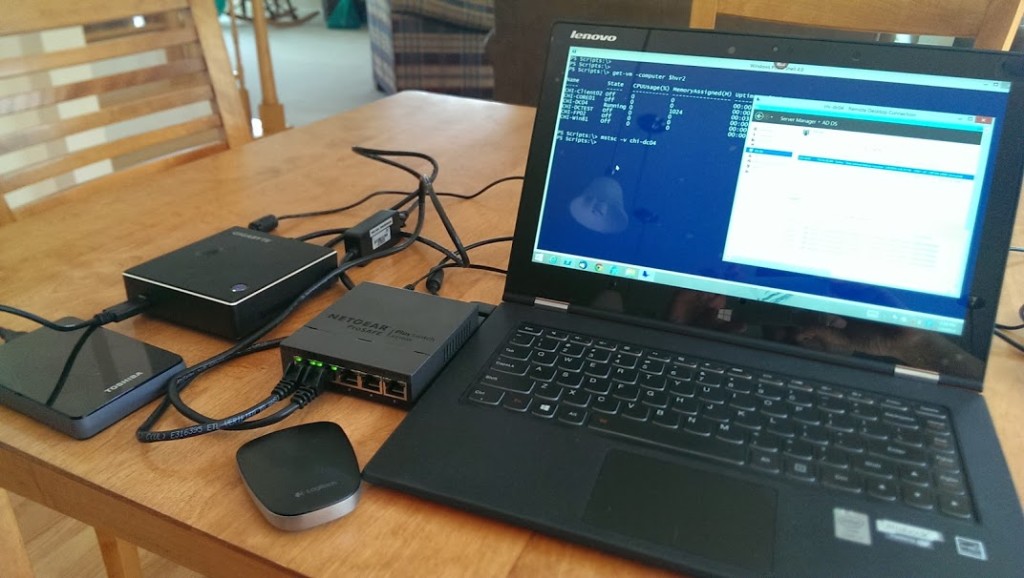 As many of you know, I typically travel with a mobile Hyper-V setup using a mini-server housed in a Gigabyte Brix unit. I also have a brand new Lenovo Yoga 2 Pro, which I've also written about. During the recent PowerShell Summit my intent was to use this gear during my presentations and demos. Sadly, I forgot the power cord to my Brix. Fortunately, Don Jones was inspired by my setup to build one of his own so I was a able to borrow his power cord for my second demonstration. But then this roller coaster brought me back down as I couldn't get network connectivity to work using an old 4 port switch. I ended up re-working demos to do everything on my Yoga 2 Pro, which wasn't too bad since it has 8GB of RAM. But I really wanted the additional virtual machines.
As many of you know, I typically travel with a mobile Hyper-V setup using a mini-server housed in a Gigabyte Brix unit. I also have a brand new Lenovo Yoga 2 Pro, which I've also written about. During the recent PowerShell Summit my intent was to use this gear during my presentations and demos. Sadly, I forgot the power cord to my Brix. Fortunately, Don Jones was inspired by my setup to build one of his own so I was a able to borrow his power cord for my second demonstration. But then this roller coaster brought me back down as I couldn't get network connectivity to work using an old 4 port switch. I ended up re-working demos to do everything on my Yoga 2 Pro, which wasn't too bad since it has 8GB of RAM. But I really wanted the additional virtual machines.
ManageEngine ADManager Plus - Download Free Trial
Exclusive offer on ADManager Plus for US and UK regions. Claim now!
When I returned home I decided the switch was the core of my problems and needed something that my laptop would recognize as a valid network device, even if it was the first device plugged in. I found a Netgear ProSafe Plus 4 port (GS105E) switch from my local Staples. Love it. I plugged my Yoga 2 Pro in, I bought a USB3 ethernet dongle, and right away Windows said I had a 1GB network connection, albeit without Internet which was fine since I don't rely on the Internet for my demos or training. I plugged in the Brix, fired it up and it just worked. That's all I ever wanted: plug it in and work.
Here's my setup, plugged in and working just as it would be at a conference or training site.
For the record, I have a USB 3 Toshiba drive plugged into the Brix that holds ISOs, backups and other large, static files. I have a USB 3 hub and another Toshiba USB 3 drive for my Yoga 2 Pro, although right now I don't need that as part of my demo/training setup. The mouse is a Logitech Bluetooth mouse that is compact and just works. I tried other Bluetooth mice with varying degrees of success. I also like that the mouse gets like an hour of run time even when charged via USB for literally one minute. Very happy to finally have a setup I can rely on. I'm looking forward to trying it out next week while I am on the road.
If you have any questions, please don't hesitate to ask.


I have been using two Core i3 Brix units (first generation) on my production (small consulting firm) network for several months now and find them fantastic devices for Hyper-V hosting. One unit runs WS 2012 R2 with Hyper-V role, the other Hyper-V Server 2012 R2. Both have the max of 16 GB of RAM and a 256 GB mSATA drive, plus USB 3.0 external hard drives and USB 3.0 Gigabit Ethernet dongles so I can manage the boxes over one network connection and dedicate the other to VM use. One Brix hosts my externally accessible Remote Desktop server (protected by Duo Security two-factor auth) and an internal WSS 3.0 server on WS2008R2, the other hosts a domain controller, external web server, DHCP and adhoc server, and also a WS2008R2 box hosting Lansweeper for all my internal monitoring, alerting, reporting, etc. Very low power usage, no noise to speak of, little heat generated (compared to a full-blow server with mechanical hard drives), and easily backed up to a NAS server using Windows Server backup.
I can’t say enough good things about these little Brix units.
I got the i7 maxed out at 16GB RAM and I think the same 256GB SSD. They are awesome and I love the form factor for travel. Thinking about getting a second one so I can setup up Hyper-V replication and/or add more servers to my test network. Thanks for sharing.
Looks like I’ve been living under a rock! This is simply brilliant! Honestly, with the right level of RAM and disk space, this is a perfect tiny lab to play around with